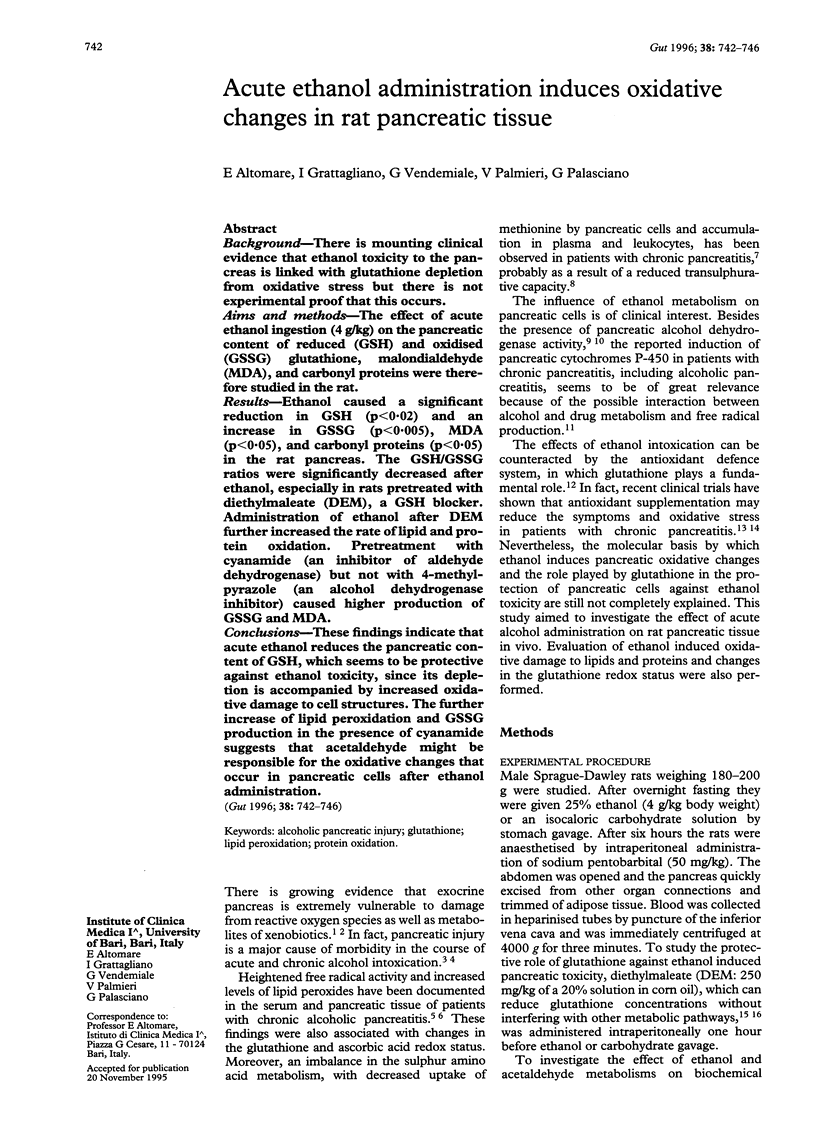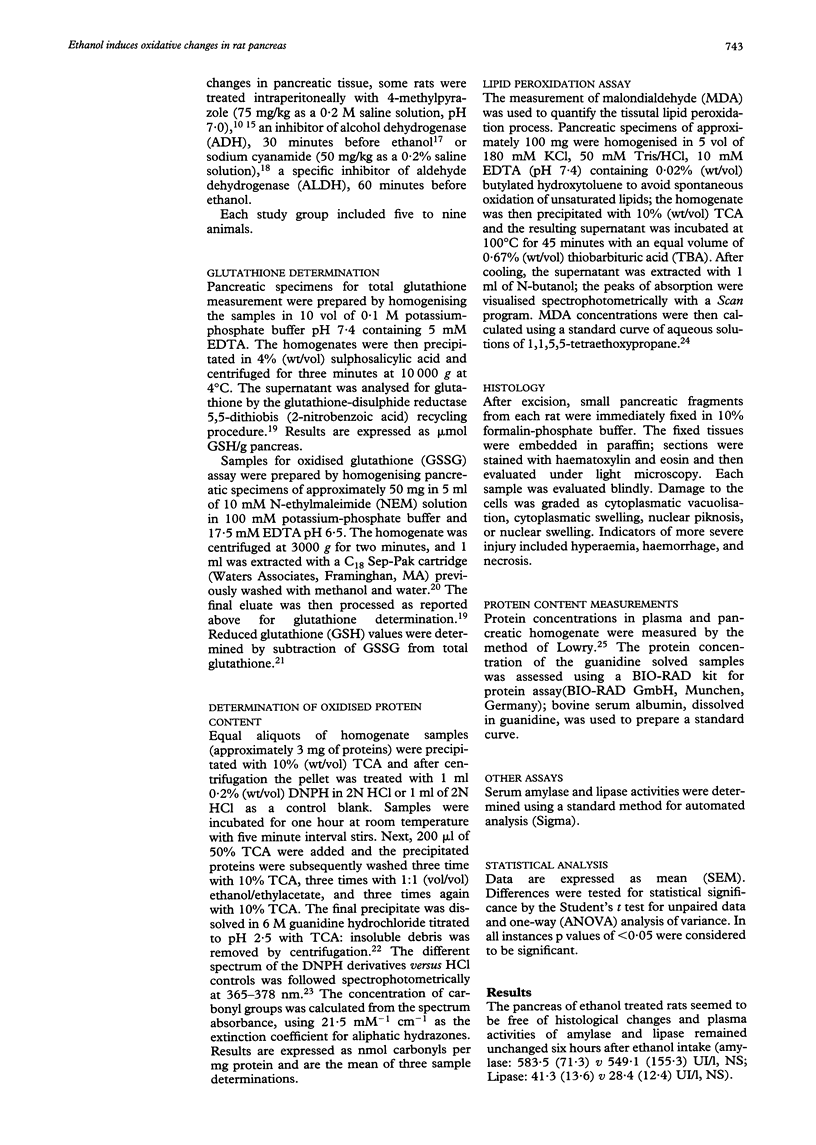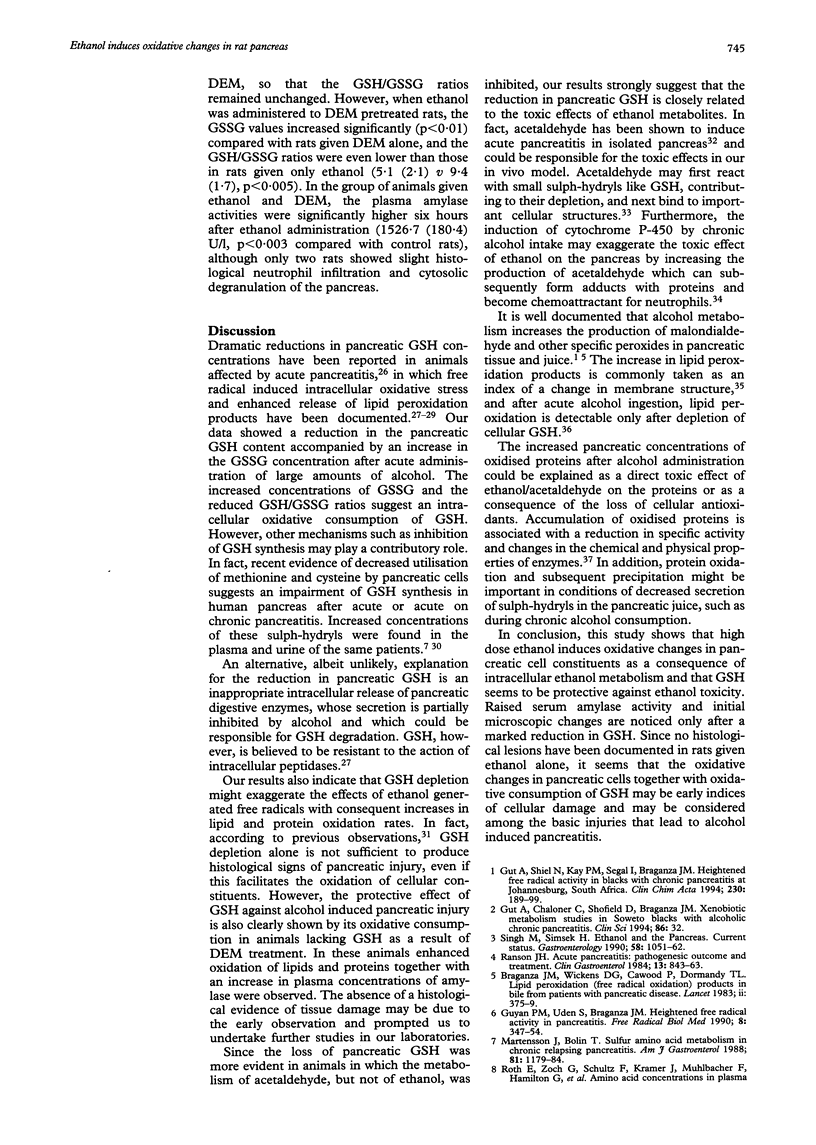Abstract
BACKGROUND--There is mounting clinical evidence that ethanol toxicity to the pancreas is linked with glutathione depletion from oxidative stress but there is not experimental proof that this occurs. AIMS AND METHODS--The effect of acute ethanol ingestion (4 g/kg) on the pancreatic content of reduced (GSH) and oxidised (GSSG) glutathione, malondialdehyde (MDA), and carbonyl proteins were therefore studied in the rat. RESULTS--Ethanol caused a significant reduction in GSH (p < 0.02) and an increase in GSSG (p < 0.005), MDA (p < 0.05), and carbonyl proteins (p < 0.05) in the rat pancreas. The GSH/GSSG ratios were significantly decreased after ethanol, especially in rats pretreated with diethylmaleate (DEM), a GSH blocker. Administration of ethanol after DEM further increased the rate of lipid and protein oxidation. Pretreatment with cyanamide (an inhibitor of aldehyde dehydrogenase) but not with 4-methylpyrazole (an alcohol dehydrogenase inhibitor) caused higher production of GSSG and MDA. CONCLUSIONS--These findings indicate that acute ethanol reduces the pancreatic content of GSH, which seems to be protective against ethanol toxicity, since its depletion is accompanied by increased oxidative damage to cell structures. The further increase of lipid peroxidation and GSSG production in the presence of cyanamide suggests that acetaldehyde might be responsible for the oxidative changes that occur in pancreatic cells after ethanol administration.
Full text
PDF




Selected References
These references are in PubMed. This may not be the complete list of references from this article.
- Adams J. D., Jr, Lauterburg B. H., Mitchell J. R. Plasma glutathione and glutathione disulfide in the rat: regulation and response to oxidative stress. J Pharmacol Exp Ther. 1983 Dec;227(3):749–754. [PubMed] [Google Scholar]
- Braganza J. M., Wickens D. G., Cawood P., Dormandy T. L. Lipid-peroxidation (free-radical-oxidation) products in bile from patients with pancreatic disease. Lancet. 1983 Aug 13;2(8346):375–379. doi: 10.1016/s0140-6736(83)90347-1. [DOI] [PubMed] [Google Scholar]
- Dabrowski A., Chwiećko M. Oxygen radicals mediate depletion of pancreatic sulfhydryl compounds in rats with cerulein-induced acute pancreatitis. Digestion. 1990;47(1):15–19. doi: 10.1159/000200470. [DOI] [PubMed] [Google Scholar]
- Deitrich R. A., Troxell P. A., Worth W. S. Inhibition of aldehyde dehydrogenase in brain and liver by cyanamide. Biochem Pharmacol. 1976 Dec 15;25(24):2733–2737. doi: 10.1016/0006-2952(76)90265-3. [DOI] [PubMed] [Google Scholar]
- Estival A., Clemente F., Ribet A. Ethanol metabolism by the rat pancreas. Toxicol Appl Pharmacol. 1981 Nov;61(2):155–165. doi: 10.1016/0041-008x(81)90404-x. [DOI] [PubMed] [Google Scholar]
- Feierman D. E., Cederbaum A. I. Increased content of cytochrome P-450 and 4-methylpyrazole binding spectrum after 4-methylpyrazole treatment. Biochem Biophys Res Commun. 1985 Feb 15;126(3):1076–1081. doi: 10.1016/0006-291x(85)90295-5. [DOI] [PubMed] [Google Scholar]
- Fernandez-Checa J. C., Ookhtens M., Kaplowitz N. Effect of chronic ethanol feeding on rat hepatocytic glutathione. Compartmentation, efflux, and response to incubation with ethanol. J Clin Invest. 1987 Jul;80(1):57–62. doi: 10.1172/JCI113063. [DOI] [PMC free article] [PubMed] [Google Scholar]
- Foster J. R., Idle J. R., Hardwick J. P., Bars R., Scott P., Braganza J. M. Induction of drug-metabolizing enzymes in human pancreatic cancer and chronic pancreatitis. J Pathol. 1993 Apr;169(4):457–463. doi: 10.1002/path.1711690412. [DOI] [PubMed] [Google Scholar]
- Gut A., Shiel N., Kay P. M., Segal I., Braganza J. M. Heightened free radical activity in blacks with chronic pancreatitis at Johannesburg, South Africa. Clin Chim Acta. 1994 Oct 31;230(2):189–199. doi: 10.1016/0009-8981(94)90271-2. [DOI] [PubMed] [Google Scholar]
- Guyan P. M., Uden S., Braganza J. M. Heightened free radical activity in pancreatitis. Free Radic Biol Med. 1990;8(4):347–354. doi: 10.1016/0891-5849(90)90100-w. [DOI] [PubMed] [Google Scholar]
- Hamamoto T., Yamada S., Hirayama C. Nonoxidative metabolism of ethanol in the pancreas; implication in alcoholic pancreatic damage. Biochem Pharmacol. 1990 Jan 15;39(2):241–245. doi: 10.1016/0006-2952(90)90022-d. [DOI] [PubMed] [Google Scholar]
- Kera Y., Ohbora Y., Komura S. The metabolism of acetaldehyde and not acetaldehyde itself is responsible for in vivo ethanol-induced lipid peroxidation in rats. Biochem Pharmacol. 1988 Oct 1;37(19):3633–3638. doi: 10.1016/0006-2952(88)90395-4. [DOI] [PubMed] [Google Scholar]
- Kobayashi T., Robinson M. K., Robinson V., DeRosa E., Wilmore D. W., Jacobs D. O. Glutathione depletion alters hepatocellular high-energy phosphate metabolism. J Surg Res. 1993 Mar;54(3):189–195. doi: 10.1006/jsre.1993.1030. [DOI] [PubMed] [Google Scholar]
- LOWRY O. H., ROSEBROUGH N. J., FARR A. L., RANDALL R. J. Protein measurement with the Folin phenol reagent. J Biol Chem. 1951 Nov;193(1):265–275. [PubMed] [Google Scholar]
- Lauterburg B. H., Bilzer M. Mechanisms of acetaldehyde hepatotoxicity. J Hepatol. 1988 Dec;7(3):384–390. doi: 10.1016/s0168-8278(88)80012-6. [DOI] [PubMed] [Google Scholar]
- Levine R. L., Garland D., Oliver C. N., Amici A., Climent I., Lenz A. G., Ahn B. W., Shaltiel S., Stadtman E. R. Determination of carbonyl content in oxidatively modified proteins. Methods Enzymol. 1990;186:464–478. doi: 10.1016/0076-6879(90)86141-h. [DOI] [PubMed] [Google Scholar]
- Levine R. L. Mixed-function oxidation of histidine residues. Methods Enzymol. 1984;107:370–376. doi: 10.1016/0076-6879(84)07025-7. [DOI] [PubMed] [Google Scholar]
- Mårtensson J., Bolin T. Sulfur amino acid metabolism in chronic relapsing pancreatitis. Am J Gastroenterol. 1986 Dec;81(12):1179–1184. [PubMed] [Google Scholar]
- Mårtensson J., Jain A., Meister A. Glutathione is required for intestinal function. Proc Natl Acad Sci U S A. 1990 Mar;87(5):1715–1719. doi: 10.1073/pnas.87.5.1715. [DOI] [PMC free article] [PubMed] [Google Scholar]
- Neuschwander-Tetri B. A., Ferrell L. D., Sukhabote R. J., Grendell J. H. Glutathione monoethyl ester ameliorates caerulein-induced pancreatitis in the mouse. J Clin Invest. 1992 Jan;89(1):109–116. doi: 10.1172/JCI115550. [DOI] [PMC free article] [PubMed] [Google Scholar]
- Nordback I. H., MacGowan S., Potter J. J., Cameron J. L. The role of acetaldehyde in the pathogenesis of acute alcoholic pancreatitis. Ann Surg. 1991 Dec;214(6):671–678. doi: 10.1097/00000658-199112000-00006. [DOI] [PMC free article] [PubMed] [Google Scholar]
- Ranson J. H. Acute pancreatitis: pathogenesis, outcome and treatment. Clin Gastroenterol. 1984 Sep;13(3):843–863. [PubMed] [Google Scholar]
- Roth E., Zöch G., Schulz F., Karner J., Mühlbacher F., Hamilton G., Mauritz W., Sporn P., Funovics J. Amino acid concentrations in plasma and skeletal muscle of patients with acute hemorrhagic necrotizing pancreatitis. Clin Chem. 1985 Aug;31(8):1305–1309. [PubMed] [Google Scholar]
- Sanfey H., Bulkley G. B., Cameron J. L. The pathogenesis of acute pancreatitis. The source and role of oxygen-derived free radicals in three different experimental models. Ann Surg. 1985 May;201(5):633–639. doi: 10.1097/00000658-198505000-00013. [DOI] [PMC free article] [PubMed] [Google Scholar]
- Schoenberg M. H., Büchler M., Gaspar M., Stinner A., Younes M., Melzner I., Bültmann B., Beger H. G. Oxygen free radicals in acute pancreatitis of the rat. Gut. 1990 Oct;31(10):1138–1143. doi: 10.1136/gut.31.10.1138. [DOI] [PMC free article] [PubMed] [Google Scholar]
- Schofield D., Mei G., Braganza J. M. Some pitfalls in the measurement of blood glutathione. Clin Sci (Lond) 1993 Aug;85(2):213–218. doi: 10.1042/cs0850213. [DOI] [PubMed] [Google Scholar]
- Singh M., Simsek H. Ethanol and the pancreas. Current status. Gastroenterology. 1990 Apr;98(4):1051–1062. doi: 10.1016/0016-5085(90)90033-w. [DOI] [PubMed] [Google Scholar]
- Slater T. F., Sawyer B. C. The stimulatory effects of carbon tetrachloride and other halogenoalkanes on peroxidative reactions in rat liver fractions in vitro. General features of the systems used. Biochem J. 1971 Aug;123(5):805–814. doi: 10.1042/bj1230805. [DOI] [PMC free article] [PubMed] [Google Scholar]
- Stadtman E. R. Protein oxidation and aging. Science. 1992 Aug 28;257(5074):1220–1224. doi: 10.1126/science.1355616. [DOI] [PubMed] [Google Scholar]
- Syrota A., Dop-Ngassa M., Cerf M., Paraf A. 11C-L-methionine for evaluation of pancreatic exocrine function. Gut. 1981 Nov;22(11):907–915. doi: 10.1136/gut.22.11.907. [DOI] [PMC free article] [PubMed] [Google Scholar]
- Tietze F. Enzymic method for quantitative determination of nanogram amounts of total and oxidized glutathione: applications to mammalian blood and other tissues. Anal Biochem. 1969 Mar;27(3):502–522. doi: 10.1016/0003-2697(69)90064-5. [DOI] [PubMed] [Google Scholar]
- Uden S., Bilton D., Nathan L., Hunt L. P., Main C., Braganza J. M. Antioxidant therapy for recurrent pancreatitis: placebo-controlled trial. Aliment Pharmacol Ther. 1990 Aug;4(4):357–371. doi: 10.1111/j.1365-2036.1990.tb00482.x. [DOI] [PubMed] [Google Scholar]
- Uden S., Schofield D., Miller P. F., Day J. P., Bottiglier T., Braganza J. M. Antioxidant therapy for recurrent pancreatitis: biochemical profiles in a placebo-controlled trial. Aliment Pharmacol Ther. 1992 Apr;6(2):229–240. doi: 10.1111/j.1365-2036.1992.tb00266.x. [DOI] [PubMed] [Google Scholar]
- Vendemiale G., Altomare E., Grattagliano I., Albano O. Increased plasma levels of glutathione and malondialdehyde after acute ethanol ingestion in humans. J Hepatol. 1989 Nov;9(3):359–365. doi: 10.1016/0168-8278(89)90146-3. [DOI] [PubMed] [Google Scholar]
- Williams A. J., Barry R. E. Superoxide anion production and degranulation of rat neutrophils in response to acetaldehyde-altered liver cell membranes. Clin Sci (Lond) 1986 Sep;71(3):313–318. doi: 10.1042/cs0710313. [DOI] [PubMed] [Google Scholar]


